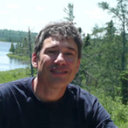Spatial variability in tree regeneration after wildfire delays and dampens future bark beetle outbreaks.
Клучни зборови
Апстракт
Climate change is altering the frequency and severity of forest disturbances such as wildfires and bark beetle outbreaks, thereby increasing the potential for sequential disturbances to interact. Interactions can amplify or dampen disturbances, yet the direction and magnitude of future disturbance interactions are difficult to anticipate because underlying mechanisms remain poorly understood. We tested how variability in postfire forest development affects future susceptibility to bark beetle outbreaks, focusing on mountain pine beetle (Dendroctonus ponderosae) and Douglas-fir beetle (Dendroctonus pseudotsugae) in forests regenerating from the large high-severity fires that affected Yellowstone National Park in Wyoming in 1988. We combined extensive field data on postfire tree regeneration with a well-tested simulation model to assess susceptibility to bark beetle outbreaks over 130 y of stand development. Despite originating from the same fire event, among-stand variation in forest structure was very high and remained considerable for over a century. Thus, simulated emergence of stands susceptible to bark beetles was not temporally synchronized but was protracted by several decades, compared with stand development from spatially homogeneous regeneration. Furthermore, because of fire-mediated variability in forest structure, the habitat connectivity required to support broad-scale outbreaks and amplifying cross-scale feedbacks did not develop until well into the second century after the initial burn. We conclude that variability in tree regeneration after disturbance can dampen and delay future disturbance by breaking spatiotemporal synchrony on the landscape. This highlights the importance of fostering landscape variability in the context of ecosystem management given changing disturbance regimes.


